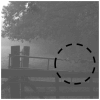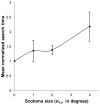Impact of simulated central scotomas on visual search in natural scenes
- PMID: 22885785
- PMCID: PMC3432450
- DOI: 10.1097/OPX.0b013e318267a914
Impact of simulated central scotomas on visual search in natural scenes
Abstract
Purpose: In performing search tasks, the visual system encodes information across the visual field at a resolution inversely related to eccentricity and deploys saccades to place visually interesting targets upon the fovea, where resolution is highest. The serial process of fixation, punctuated by saccadic eye movements, continues until the desired target has been located. Loss of central vision restricts the ability to resolve the high spatial information of a target, interfering with this visual search process. We investigate oculomotor adaptations to central visual field loss with gaze-contingent artificial scotomas.
Methods: Spatial distortions were placed at random locations in 25° square natural scenes. Gaze-contingent artificial central scotomas were updated at the screen rate (75 Hz) based on a 250 Hz eye tracker. Eight subjects searched the natural scene for the spatial distortion and indicated its location using a mouse-controlled cursor.
Results: As the central scotoma size increased, the mean search time increased [F(3,28) = 5.27, p = 0.05], and the spatial distribution of gaze points during fixation increased significantly along the x [F(3,28) = 6.33, p = 0.002] and y [F(3,28) = 3.32, p = 0.034] axes. Oculomotor patterns of fixation duration, saccade size, and saccade duration did not change significantly, regardless of scotoma size.
Conclusions: There is limited automatic adaptation of the oculomotor system after simulated central vision loss.
Figures






Similar articles
-
The influence of artificial scotomas on eye movements during visual search.Optom Vis Sci. 2005 Jan;82(1):27-35. Optom Vis Sci. 2005. PMID: 15630401
-
Domain Specificity of Oculomotor Learning after Changes in Sensory Processing.J Neurosci. 2017 Nov 22;37(47):11469-11484. doi: 10.1523/JNEUROSCI.1208-17.2017. Epub 2017 Oct 20. J Neurosci. 2017. PMID: 29054879 Free PMC article.
-
Saccadic adaptation in the presence of artificial central scotomas.J Vis. 2021 Jan 4;21(1):8. doi: 10.1167/jov.21.1.8. J Vis. 2021. PMID: 33439238 Free PMC article.
-
Impairment of visual memory for objects in natural scenes by simulated central scotomata.J Vis. 2016;16(2):6. doi: 10.1167/16.2.6. J Vis. 2016. PMID: 27002551
-
Adaptation to a simulated central scotoma during visual search training.Vision Res. 2014 Mar;96:75-86. doi: 10.1016/j.visres.2014.01.005. Epub 2014 Jan 21. Vision Res. 2014. PMID: 24456805
Cited by
-
Eye Movements in Macular Degeneration.Annu Rev Vis Sci. 2021 Sep 15;7:773-791. doi: 10.1146/annurev-vision-100119-125555. Epub 2021 May 26. Annu Rev Vis Sci. 2021. PMID: 34038144 Free PMC article. Review.
-
Saccades during visual search in macular degeneration.Vision Res. 2022 Dec;201:108113. doi: 10.1016/j.visres.2022.108113. Epub 2022 Aug 18. Vision Res. 2022. PMID: 35988396 Free PMC article.
-
Distinct visual processing networks for foveal and peripheral visual fields.Commun Biol. 2024 Oct 4;7(1):1259. doi: 10.1038/s42003-024-06980-2. Commun Biol. 2024. PMID: 39367101 Free PMC article.
-
Peripheral oculomotor training in individuals with healthy visual systems: Effects of training and training transfer.Vision Res. 2017 Apr;133:95-99. doi: 10.1016/j.visres.2016.10.016. Epub 2017 Feb 27. Vision Res. 2017. PMID: 28192092 Free PMC article.
-
New challenges in low-vision research.Optom Vis Sci. 2012 Sep;89(9):1244-5. doi: 10.1097/OPX.0b013e31826ba359. Optom Vis Sci. 2012. PMID: 22926111 Free PMC article. No abstract available.
References
-
- Kosnik W, Kline D, Fikre J, Sekuler R. Ocular fixation control as a function of age and exposure duration. Psychol Aging. 1987;2:302–5. - PubMed
-
- Klein R, Klein BE, Tomany SC, Meuer SM, Huang GH. Ten-year incidence and progression of age-related maculopathy: The Beaver Dam eye study. Ophthalmology. 2002;109:1767–79. - PubMed
-
- Burke W. Psychophysical observations concerned with a foveal lesion (macular hole) Vision Res. 1999;39:2421–7. - PubMed
-
- Von Noorden GK, Mackensen G. Phenomenology of eccentric fixation. Am J Ophthalmol. 1962;53:642–60. - PubMed
-
- Whittaker SG, Cummings RW, Swieson LR. Saccade control without a fovea. Vision Res. 1991;31:2209–18. - PubMed
Publication types
MeSH terms
Grants and funding
LinkOut - more resources
Full Text Sources
Medical
Research Materials
Miscellaneous

